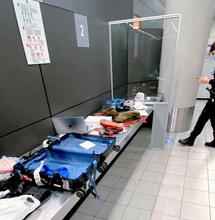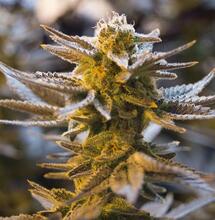Indoor Marijuana Plants and Carbon Dioxide

Carbon dioxide must be present in some form for plant growth to occur, and a well-tuned garden can benefit from additional carbon dioxide.
Carbon dioxide must be present in some form for plant growth to occur, and a well-tuned garden can benefit from additional carbon dioxide.
Carbon dioxide has one carbon atom attached to two oxygen atoms and is a colorless and, unless at very high concentration, orderless gas (at room temperatures and pressure). There are several methods of introducing CO2 into a garden space.
Plants use carbon dioxide via small openings, called 'stomata', in the epidermal or outer skin layer of the undersides of leaves. These openings allow for carbon dioxide (CO2) to be absorbed for use in photosynthesis and allow the plant to vent off oxygen (O2) and water vapor (H2O). The reaction takes in six water and six carbon dioxide molecules, plus light, to form one sugar and six oxygen molecules. It vents off the oxygen and uses the sugar for growth. A shortage of carbon dioxide will hinder or even prevent growth, while a moderate excess will allow the plant to thrive in a warmer-than-usual environment.
Surrounding the stomata openings are guard cells that allow the stomata to open when light and moisture are conducive to growth and to close in times of drought, high heat and darkness. This is why supplemental CO2 is generally used during only the lit hours of a garden - unless there is no way to turn it off.
Carbon dioxide is a requirement for plant growth. There are several carbon dioxide sources that can be used.
Fresh air contains about 400 parts-per-million of carbon dioxide (and thanks to pollution is rising at a rate of at least two ppm a year, which is good news for plants and bad news for the rest of us). This is enough for normal plant growth and is as simple as removing carbon dioxide-poor air from inside of the garden and replacing it with fresh air from outside of the garden. Fans are used to move the air, with higher cubic feet-per-minute (CFM) rated fans moving more air. Plants grown in nature use the available carbon dioxide in fresh air.
|
This regulator attaches to a tank to slowly release carbon dioxide |
To reach levels higher than atmospheric conditions, additional carbon dioxide can be added. The garden's ventilation is configured differently than one that uses fresh air in order to prevent the additional carbon dioxide from simply venting out of the room. As a result, the rooms are sealed and do not exchange the garden air with fresh air. The additional CO2 must be at a level over 400 ppm in order to be a benefit over fresh air exchanging, commonly in the range of 1,000 to 1,300 ppm (higher levels have little additional effect and extremely high levels may hinder growth).
This additional carbon dioxide may come from a synthetic or natural source.
When burned, natural gas, propane and liquid fuels give off carbon dioxide and specialized carbon dioxide-generating burners are sold for this purpose. These are most commonly used in large greenhouses and are less well suited for small indoor gardens. These burners are a heat source as well, which must be taken into account when planning cooling requirements. Since there are inherent dangers in their use (e.g., flames and fuel in an enclosed space), I do not recommend their use in home gardens.
Compressed CO2 tanks can also be used. These are used with a regulator that allow the gas to be slowly released over a long period of time. Tanks of compressed carbon dioxide are available at many hydroponic stores as well as traditional commercial outlets. This is a popular method with home indoor gardens.
Both carbon dioxide generators and CO2 tank regulators can benefit from timers - set to turn on about an hour before lighting - and/or connected to a carbon dioxide monitor to allow minimum and maximum levels to be set.
Dry ice is the frozen solid form of carbon dioxide which, if left at room temperature, will melt, releasing carbon dioxide. Since dry ice melts relatively quickly, it would need to be replaced on a regular basis, making this a labor-intensive method.
Prepackaged pads containing sodium bicarbonate, commonly known as baking soda, and citric acid can also be used. When the sodium bicarbonate and citric acid come in contact with water, they rearrange to produce sodium citrate and carbon dioxide gas.
Carbon dioxide is also a byproduct of many forms of life, a principle that can be used to enrich garden air.
|
Mushrooms and yeast give off carbon dioxide as they grow |
Yeast, when grown in carbohydrate (sugar) solutions, will produce carbon dioxide and alcohol. Yeasts are small fungi that are commonly used to produce carbon dioxide to make bread rise and also to carbonate old-fashioned sodas, beers and sparkling wines. Yeast can be mixed with sugar in a container - an airlock can help prevent unwanted things from starting to grow in it as well - and, once started, it will bubble carbon dioxide until either it runs out of sugar or kills itself with alcohol poisoning.
Larger fungi, such as oyster mushrooms, can also be employed to create CO2. Mushroom bags expressly for this purpose are sold that contain mushroom spores in a medium. As they grow throughout the medium, they give off carbon dioxide.
Carbon dioxide monitors are an expense that may well earn back their cost. Adding too little carbon dioxide defeats the purpose of not using fresh air and adding too much can be wasteful at best and dangerous at worst, since levels of 5,000 or more are not safe for humans.
Lastly, one of my favorite sources of carbon dioxide is the gardener him- or herself. As a large mammal, humans exhale carbon dioxide as part of our respiration. A gardener is a source of CO2 that can hopefully contribute to the health of the garden in other ways as well and a bit of healthy heavy breathing with a friend can be good for both the garden and the gardener - as long as care is taken not to break plants in the process.



